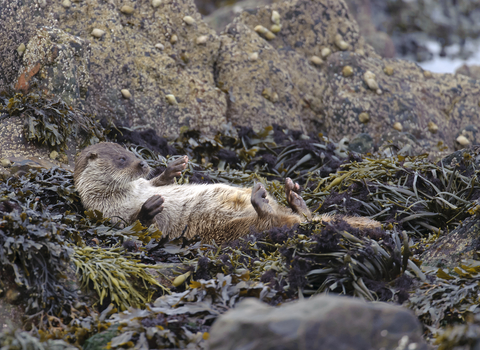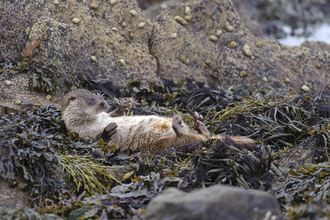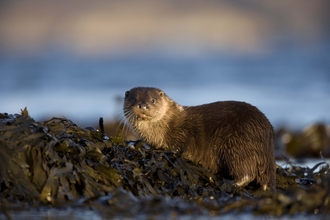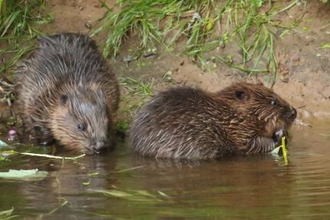European otters
Whether it a glimpse of water-webbed whiskers, a lithe body porpoising in play, or the tip of a ruddering tail, the sight of a shy otter is one of the most rewarding wildlife experiences in the UK. Pushed to the brink by hunting, habitat destruction and pesticides, the otter almost disappeared from rivers and waterways in England, surviving in small numbers in Wales, Scotland and Northern Ireland. Thankfully, after huge efforts to improve water quality and the banning of chemicals such as DDT, there are now increasingly good chances of spotting this enigmatic predator.
There is something magical about watching an otter – it is a glimpse of a conservation victory and an animal whose muscles are as fluid as the river
Find an otter near you
Do a little research in advance and find out where otters visit near you. Here are some of the places that otters have been known to haunt.
North
Cheshire Wildlife Trust
Hockenhull Platts - Within easy distance of Chester and Tarvin, Hockenhull Platts nature reserve sits beside the River Gowy and is a great place to enjoy a short stroll along the Mill Trail and over the quaint medieval bridges that traverse the reserve. Otters have been recorded along the banks of the river and it is hoped the newly created wetlands may also encourage these secretive river dwellers.
Cumbria Wildlife Trust
Wreay Woods - The reserve follows the course of the River Petteril where a deep gorge has been cut through the land. Unmanaged river channels such as this, often containing large woody debris, are now a rarity in the county. They provide ideal otter habitat and there are occasional sightings of them here. Also look for grey wagtail, dipper and kingfisher.
Durham Wildlife Trust
Shibdon Pond - One of the few large lowland, open water bodies between the Tyne and the Tees and particularly important due to its location on the urban fringe. Otters regularly use the reserve and it is also home to large cormorant and tern roosts. Look out for water rail, greenshank and sandpipers.
Lancashire Wildlife Trust
Aughton Woods - Remote ancient woodland on the River Lune, which is a hotspot for otters. It’s full of coppiced trees, including small-leaved lime. Also look out for common sandpipers and oystercatchers from February onward.
Northumberland Wildlife Trust
Druridge Bay - The Pools along Druridge Bay are the best places to spot otters. Northumberland. NWT manages five reserves along Druridge Bay: Cresswell Shore and Cresswell Pond, Druridge Pools, East Chevington and Hauxley. They are important sites for birds and other wildlife.
Tees Valley Wildlife Trust
Portrack Marsh - Take an early morning walk along the River Tees towards the reserve. Check the river and riverbank for otters which are regularly seen in and around the town. At the barrage, keep an eye out for common seal and kingfisher too.
Bowesfield - This wetland reserve is formed by three loops in the River Tees, each with its own character and special wildlife. Look out for otters along the river, as well as birds such as stonechat, water rail, curlew and sand martin in the summer months. The reedbeds are also home to reed bunting and harvest mouse.
Yorkshire Wildlife Trust
Staveley - This site is great for otters - in 2012 it was home to a mother and cubs who were seen on several occassions. It’s also home to more than 230 plant species and a range of birds, including locally rare short-eared owl and jack snipe.
Ripon City Wetlands - Created from the footprint of a working quarry, Ripon City Wetlands nature reserve is a thriving home for a range of birds and other wildlife.
Kirkstall Vallley nature reserve - Just outside the urban heart of Leeds, Leeds City Council's Kirkstall Valley Nature Reserve combines the industrial past with today's vibrant wildlife communities. A keen eye might spot otters or kingfishers by the weirs on the River Aire.
Skerne Wetlands - The jewel in the crown of Skerne Wetlands are the UK’s most northerly chalk streams, which are a nationally-important habitat in the headwaters of the River Hull. The West Beck, with its crystal clear waters, lush bankside plants and stunning beds of water crowfoot, is not to be missed in early summer.
Midlands
Derbyshire Wildlife Trust
Willington Gravel Pits - This former sand and gravel quarry provides a haven for wildlife in the Trent Valley. The flooded gravel pits form an important wetland habitat attracting many birds, including wildfowl, waders, peregrine and bittern. The site is attractive to otters and is also full of dragonflies in the summer. You will need a permit to access the hide.
Northamptonshire Wildlife Trust
Ditchford Lakes and Meadows - Part of the upper Nene valley floodplain, this complex of old gravel pits, grassland and scrub is very important for both breeding and wintering birds. Otters are frequent visitors to these lakes - look out for their distinctive footprints in the wet mud.
Staffordshire Wildlife Trust
Wolseley Centre - Otters have been caught on a special night vision camera at SWT’s Wolseley Centre HQ. A camera set up on the banks of a brook that runs into the River Trent recently captured numerous images of two otters, a female and pup, along with lots of other wildlife, including a kingfisher and wood mouse.
Doxey Marshes - Although well known as a great bird watching location, Doxey Marshes is also home to regionally significant populations of otter, which are regularly recorded on the reserve, as well as harvest mouse and water shrew. Look out for snipe, redshank and lapwing, plus bittern and the occassional rarity.
Warwickshire Wildlife Trust
Brandon Marsh - Brandon Marsh Nature Reserve is set in 220 acres and features a wide variety of large pools, bird hides, woodland walks and wildflower meadows. This former quarry has been transformed into a European Site of Special Scientific Interest (SSSI) - home to a number of iconic species including kingfisher, cuckoos and otter. The reserve is also frequented by visiting osprey, pied flycatcher and other rare migratory species. The Visitor Centre is a great place to start your visit, and includes a tea room and well-stocked gift shop. The accessible network of paths and boardwalks allow visitors to explore pools, reedbeds and woodlands and get closer to nature.
River Arrow - River Arrow reserve is a large area of grassland with a small area of woodland plus ponds and the river. Near to the centre of historic Alcester, it is valuable for locally rare small teasel and kingfishers.
Leam Valley - A fantastic nature reserve on the edge of Leamington Spa. While you're here try spotting the numerous fish in the River Leam where roach, perch and common bream lurk in the depths. A magnificent range of dragonflies and damselflies flit along its banks including banded demoiselle, darters, chasers, hawkers and the emperor dragonfly. Kingfishers can be spotted here and are known to breed along the river. The elusive grass snake may be seen as it swims amongst arrowhead, yellow water-lilies and flowering-rush.
South
Cornwall Wildlife Trust
Nansmellyn Marsh - This reserve consists of one of the few remaining untouched areas of reedbed in Cornwall. The common reed is found here, as well as numerous bird species including Cetti’s warbler. Otters can be found here, indicating a healthy aquatic ecosystem.
Hampshire Wildlife Trust
Lower Test Nature Reserve - This patchwork of floodplain meadows, marshes and reedbeds host a great range of wildlife and has regular sightings of otters. With salt and freshwater and the natural progression from land to sea, all manner of birds and flowers thrive in this watery haven.
Winnall Moors - A stone’s throw from busy Winchester, otters pass daily through this wetland haven. Look for signs of these animals from the reserve’s many paths, boardwalks and bridges over the renowned River Itchen.
Somerset Wildlife Trust
Westhay Moor - The Somerset Levels are an important site for otters. Covering more than 100 ha, Westhay Moor National Nature Reserve provides ideal habitat for them, with its mosaic of wetlands, lakes and reed beds alive with hidden wildfowl and fish. In particular look for them in the lakes off London Drove.
Wiltshire Wildlife Trust
Lower Moor Farm - Visitors here are often surprised by the diversity of habitats that belie its unassuming name. Head to Flagham Brook to find both otters and water voles among birds such as nightingale, tawny owl, woodpeckers, lapwing and snipe.
Smallbrook Meadows - Here water weaves through wet woodland, wildflower meadows, marsh, ditches and ponds. Otters are seen fleetingly, especially in the early morning. Water voles can be found here too.
Langford Lakes - With a stretch of the River Wylye, 3 lakes and a new wetland area, it is not surprising that visitors may spot otters here, as well as the elusive water vole. During summer months, the reserve is brimming with birds, dragonflies, insects and spectacular wetland wild flowers.
East
Essex Wildlife Trust
For the best chance of seeing an otter in Essex - and it’s a sighting with a difference - join a Trust-led Nightwatch, led by otter expert Darren Tansley. Infrared video cameras are used to observe wildlife at night - the time when rivers come to life. There have been some great sightings this way, including cubs. Visit their website for details of events.
Norfolk Wildlife Trust
Ranworth Broad is of national and international importance for wildlife. Situated in the middle stretches of the River Bure it forms part of the larger Bure Marshes National Nature Reserve. Otters are regularly recorded here, and there is also the chance to see large numbers of wildfowl in winter.
Barton Broad - The largest Broad in the Ant Valley. It is a man-made landscape impacted by natural processes - the open water is a result of flooded peat diggings. It is home to key species including bittern, marsh harrier, otter, fen orchid and Desmoulin’s whorl snail.
Wales
Gwent Wildlife Trust
Magor Marsh - Around 90 acres of the last relatively natural area of fenland on the Gwent Levels and GWT’s best reserve to see otters. Winter is a great time to look for signs of otters around the pond and along the reens. Also look out for birds such as snipe, teal and water rail.
Montgomeryshire Wildlife Trust
Red House - With a wild wet woodland and wet riverine meadows, it’s little wonder that otters love to spend time here! The reed swamp, pool and wet woodland are also home to more than 150 wetland plants, including the largest single population of sweet flag, a scarce Montgomeryshire plant.
The Wildlife Trust for South & West Wales
Teifi Marshes - This wetland reserve sits on the banks of the Teifi river near Cligerran. A great place to see otters with a hide set in the perfect position to do so, as well as a visitor centre and nature trails. Other possible sightings include hen harrier, bittern and kingfisher.
Radnorshire Wildlife Trust
Gilfach Farm - Visitors often report seeing otters here and last summer a family from Liverpool saw a female and two cubs walking along the nature trail in mid-afternoon! The best time to visit is Oct - Dec when otters come to the waterfalls to chase the leaping salmon.
Scotland
Scottish Wildlife Trust
Falls of Clyde - The reserve stretches along both sides of the Clyde Gorge and offers spectacular views of waterfalls. While looking for otter here also keep an eye out for peregrine, badger and bats, and learn more in the visitor centre.
Spey Bay - The largest shingle beach in Scotland. Constant erosion and deposition by the river creates a range of habitats from bare shingle to reed beds, freshwater marsh and brackish saltmarsh. Visit for a chance to see coastal otters and marine mammals such as seals and dolphins.
Loch of the Lowes - Famed for its breeding ospreys, the star attraction between Apr - Aug, the reserve is also a good place to look for otters all year round. It has a visitor centre and 98 ha of open water and woodland habitat, plus ranger-led walks, wildlife video footage and woodland bird viewing areas available.
Northern Ireland
Ulster Wildlife Trust
Glenarm Nature Reserve - The winding Glenarm River flanks this beautiful semi-natural woodland and is the perfect spot to see otter hunting for salmon and trout in the sparkling waters below. Look out too for dipper, kingfisher and grey wagtail - and in the woods winter thrushes, common crossbill, siskin and red squirrel.
Balloo Wetland - This brand new wetland nature reserve in the industrial heart of Bangor is fast becoming a haven for wildlife. With its large ponds and meandering streams, otters are occasional visitors, with signs of activity being spotted throughout the year. In winter, the ponds also play host to a range of water-loving birds including teal, redshank, lapwing and snipe.
What to look for
Dawn and dusk are good times to watch for otters. It is also when other wildlife is most active, and their behaviour may give away an otter’s presence. A flock of ducks suddenly swimming rapidly one way, glancing over their shoulders, could be a sign of an otter nearby. Keep an eye out around reedbeds too, where they often hunt. A tell-tale trail of bubbles might mean the otter has seen you first! There are other signs of the presence of otters. On muddy or sandy banks, look for tracks, or slipways made by a belly sliding otter. Investigating tree roots, riverside rocks and under bridges might turn up droppings or “spraints” that the otter uses to communicate. Ranging from black to ashy grey, they are often full of small bones and fish scales.
If you can't get to these places
Otters are thankfully now widespread and have been found on every river catchment in the country. There are records of otters on waterways in the heart of some of our biggest cities – although patience and luck are key for a sighting!
More wildlife experiences
From seeing colourful wildflowers to spotting magnificent birds of prey, we can help you get closer to wildlife across the UK.








